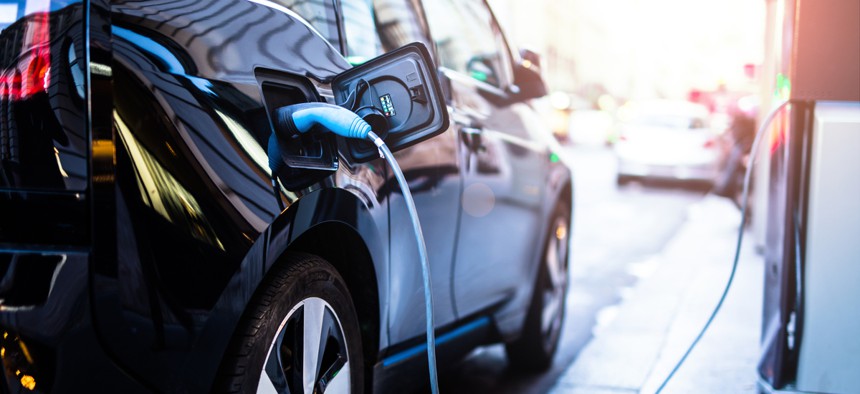
Shutterstock.com
Electric Vehicle Tax Credit Program Needs More Than Routine Maintenance
The U.S. Treasury is missing out on a program that often benefits the wealthy.
Lawmakers on Capitol Hill are working to “fix” the electric vehicle tax credit program by expanding it dramatically, but before they do anything they should take a closer look at what’s under the hood. While some policymakers want to simply throw more money at car manufacturers, reforms that would reallocate some of the tax credits and incentivize more competition in the electric vehicle market would be better for the environment and better for government coffers.
Created in 2009 as part of President Obama’s economic stimulus package, the electric vehicle (EV) tax credit program provides a credit of up to $7,500 to buyers of qualified vehicles. It limits each manufacturer to 200,000 vehicles that are eligible under the program. Once that cap is reached, it winds down the value of the credits for that particular manufacturer's EVs over a year-long period. Now that two carmakers have hit their cap and entered the phase-out period, some in Congress are trying to boost the number of available credits. Bipartisan legislation introduced by Senators Debbie Stabenow, D-Mich., and Lamar Alexander, R-Tenn., would grant each manufacturer an additional allotment of 400,000 credits worth up to $7,000. This is ill-advised, as it would deprive the U.S. Treasury of billions of dollars without addressing several problems associated with the program. If the EV program is going to continue -- and some detractors including President Trump have called for its repeal -- Congress shouldn’t expand it, but instead institute common-sense, pro-taxpayer reforms.
This should begin with the recognition that there isn’t actually a shortage of EV tax credits. According to EVAdoption, 17 auto manufacturers have sold EVs under the tax credit program. Of those, only Tesla and GM have hit the 200,000 cap and are in the phase-out stage of the program. Others, like Nissan and Toyota, should hit their caps within the next two years. But many of the other manufacturers are a long way from hitting 200,000 EV sales. Kia has sold just over 13,000 qualified vehicles. Mitsubishi is barely over 7,000 vehicles and Volkswagen is a shade over 14,000. All told there are more than 2.4 million EV tax credits available to car buyers. Most are attached to manufacturers that have not brought many qualified vehicles to market yet. Instead of increasing the tax credit pool, Congress should aggregate it by removing the manufacturer-specific cap and making the full allotment of tax credits available to all consumers, regardless of the brand of vehicle they opt to purchase.
This would not only eliminate the immediate concerns about Tesla and GM’s cap limitations, it would also encourage other manufacturers to bring more EVs to market as quickly as possible -- before the pool of tax credits is exhausted and the program is terminated. And from a taxpayer perspective, it would address these problems while maintaining revenue neutrality, because it would not add more tax credits into the mix.
But policymakers shouldn’t stop there. They should also implement reforms that bring the program more in-line with its intended purpose and limit the amount of benefits going to wealthy car buyers. As it stands, 70 percent of the tax credits are going to consumers who would have purchased an EV regardless of the tax break. Most of these buyers are significantly wealthier than the average consumer.
This isn’t fair to taxpayers. Tax credits should not be available to people who are buying a $100,000 Land Rover turbocharged electric SUV or a $200,000 Tesla Roadster. To better direct these tax breaks to people who actually need them, the credit should only apply to cars valued at less than $55,000 -- a figure that is about 50 percent more than the cost of the average car to reflect the fact that EVs tend to be more expensive than traditional cars.
Another means-testing approach would be to follow the lead of California by capping income eligibility. To qualify for California’s Clean Vehicle Rebate Program, buyers cannot have an income that exceeds $150,000 for single filers or $300,000 for joint filers. This is a reasonable measure that reduces the usage of government resources to subsidize purchases of EVs made by luxury brands like Porsche and Jaguar. On a national level, these income thresholds could probably be further reduced.
Means testing is not only a more fiscally responsible approach, it also makes the credit more effective at moving consumers away from gasoline vehicles and toward EVs because there is greater price sensitivity for lower-cost cars. That is to say, a credit that reduces the cost of an EV from $35,000 to $27,500 will result in a much larger behavioral response than that same $7,500 credit if used to reduce a vehicle’s cost from $95,000 to $87,500.
The EV tax credit was established to nudge people in the direction of more environmentally friendly purchases and to bring down the cost of cars that might have otherwise been too expensive. They have become increasingly popular as consumers purchased more than 361,000 EVs in 2018, which far exceeded 2017’s total figure of fewer than 200,000. Early data from 2019 suggest that last year’s record sales will be topped once again -- especially as new, more affordable models become available. The EV tax credit deserves partial credit for this trend, as it drove a 29 percent increase in sales. Still, too many of the credits went to wealthier consumers who were already planning on buying EVs.
The EV tax credit program is now at a crossroads. Instead of expanding it as some lawmakers on Capitol Hill would do, it’s time to enact reforms that make it more effective and fiscally responsible in the short-term and -- if market trends continue -- completely unnecessary in the longer term.
Brandon Arnold is the Executive Vice President of the National Taxpayers Union, a nonprofit dedicated to advocating for taxpayers at all levels of government.






